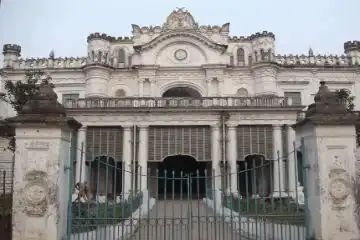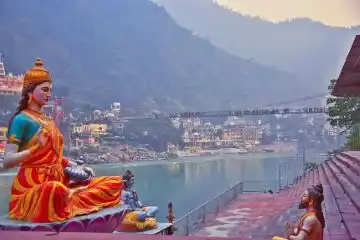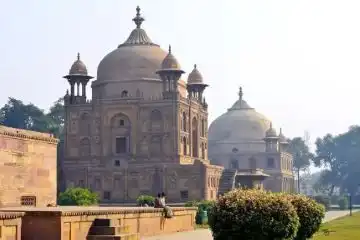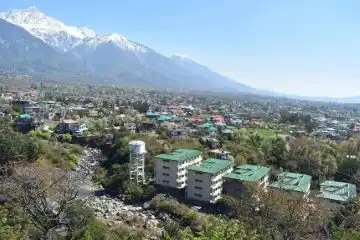Experience the beauty of historical places in Murshidabad
Steeped in the grandeur of Nawabi rule and the charm of colonial architecture, Murshidabad is a historical haven. The historical places in Murshidabad had once stood as Bengal's pride. Nestled on the banks of the serene Bhagirathi River, this is firstly a culturally rich town. It was the seat of power for Bengal's Nawabs. Above all, it was a major center for trade and politics during the 18th century.
The historical places in Murshidabad offer a mesmerizing journey through time. They firstly showcase a blend of Mughal, European, and Bengali architectural influences. That goes from magnificent palaces and ancient mosques to colonial-era relics and intricate temples. Above all, Murshidabad is a paradise for history enthusiasts and curious travelers alike.
Let's dive further into the most captivating historical places in Murshidabad city. That bring Murshidabad's illustrious past alive.
1. Hazarduari Palace - The Pride of Murshidabad
Standing tall as Murshidabad's most iconic landmark, the Hazarduari Palace or the "Palace of a Thousand Doors". This masterpiece of Indo-European architecture was built in 1837 by British architect Duncan MacLeod. That makes it one of the famous historical places in Murshidabad to explore once. However, he made it for Nawab Nazim Humayun Jah. It further symbolizes the grandeur of the Nawabi era.
The palace contains 100 real doors and 900 false ones designed to confuse invaders. It is a unique feature reflecting the security concerns of the time. The architectural and cultural attractions in Kolkata are also a delight to explore for history lovers. Today, it further operates as a museum under the Archaeological Survey of India. That meanwhile showcase an incredible collection of royal artifacts, weapons, rare manuscripts, and European paintings.
Visitors can marvel at the giant chandeliers in the Durbar Hall and explore the Nawabs' prized possessions. They can meanwhile walk through history in one of Bengal's most significant heritage structures.
2. Nizamat Imambara - The Grandeur of Shia Heritage
Right opposite the Hazarduari Palace stands the grand Nizamat Imambara, built in 1847 by Nawab Nazim Mansur Ali Khan. It's one of India's largest Imambaras and serves as a center for Shia Muslim rituals, especially during Muharram.
The whitewashed building is renowned for its intricate stucco work, large prayer halls, and serene courtyards. During significant religious events, the Imambara transforms into a hub of spiritual energy, drawing thousands of visitors.
A walk through its sacred halls provides insight into the religious fabric and historical places in Murshidabad. It further shows its connection to Persia-inspired Shia traditions.
3. Katra Mosque - The Resting Place of Nawab Murshid
One of the oldest mosques in Bengal, Katra Mosque was built by Murshid Quli Khan. He was the founder of Murshidabad, during 1723. Interestingly, the Nawab himself is buried beneath the steps of this mosque. However, it was done to fulfill his wish to rest humbly under the feet of worshippers.
Further, the mosque's grand minarets once allowed a panoramic view of the entire town. Though partially damaged by earthquakes, there are few surviving minarets. Their intricate carvings, and the austere structure stand as a symbol of Islamic architectural heritage.
Visitors are meanwhile drawn to the spiritual atmosphere and the historical significance of this majestic mosque.
4. Katgola Palace - Echoes of Trade and Jain Heritage
Unlike Murshidabad's royal residences, Katgola Palace belonged to a wealthy Jain merchant family. Dugar family who were prominent traders during British rule had built this palace. The palace meanwhile displays a striking fusion of European, Mughal, and Bengali architecture.
Known for its ornate woodwork, Venetian chandeliers, and Italian marble statues, the Katgola Palace. It further features beautiful frescoes and an expansive garden. That was once used for entertaining British officers and elite guests.
Adjacent to the palace lies the Jain temple of Adinath, which adds spiritual significance. It meanwhile reflects the deep-rooted Jain influence on Murshidabad's socio-economic history.
5. Jahan Kosha Cannon - Symbol of Power and Warfare
The mighty Jahan Kosha Cannon, meaning "Destroyer of the World", is an awe-inspiring relic of medieval weaponry. Cast in 1637 by craftsman Janardan Karmakar, this is a 17-18 ton cannon. Above all, it is a remarkable example of metallurgical excellence.
Resting in the Topekhana area near Katra Mosque, the cannon is six meters long. It stands out further with inscriptions that tell stories of the region's turbulent past. Visitors can marvel at its size and craftsmanship-a testament to Murshidabad's military significance.
However, standing next to it, one can almost hear the echoes of battles that once shaped Bengal's destiny.
6. Nasipur Palace - A Glimpse into Colonial Power Dynamics
Nasipur Palace, also known as Nasipur Rajbari, reflects the political complexities of Bengal under British rule. It was constructed by Debi Singha, a tax collector for the British East India Company. The palace stands as a symbol of wealth and power amassed by revenue officers during colonial times.
The structure features neoclassical influences with sprawling courtyards, wide verandahs, and ornate decorations. Adjacent to it is the beautiful Ramachandra Temple, known for its terracotta designs. That further depict episodes from Hindu mythology.
A visit to Nasipur Palace firstly offers a unique perspective on Bengal's colonial-era societal structure.
7. Motijheel - The Pleasure Retreat of Nawabs
Known as the "Pearl Lake", Motijheel is an artificial oxbow lake. Above all, this lake is surrounded by remnants of palaces, mosques, and colonial structures. It served as a recreational retreat for Nawab Alivardi Khan. After that, it had witnessed many events that altered Bengal's political landscape.
The British, French, and Dutch all left their imprints on Motijheel. That further turned it into a hub of diplomacy and trade. Today, the serene waterbody and surrounding ruins provide a peaceful escape for visitors. So that, they can meanwhile soak in nature and history.
A boat ride here further offers stunning views of Murshidabad's forgotten heritage.
8. Tomb of Azimunnisa Begum - Bengal's Forgotten Princess
Azimunnisa Begum, the beloved daughter of Murshid Quli Khan, rests in a serene tomb. This is one of the famous historical places in Murshidabad that further speaks about untold love and folklore. Dubbed "Bengal's Mumtaz Mahal", she is remembered for her charitable works and tragic death.
Located near the Bhagirathi River, the tomb displays modest Mughal-style architecture. It is shrouded in local legends, further making it a site of historical intrigue.
Visiting the tomb connects you with the emotional tales of Murshidabad's royal family. It further offers you insights about their deep impact on the region's heritage.
9. Rosnaiganj Dutch Cemetery - Traces of European Influence
Beyond the Nawabi legacy, Murshidabad also carries European footprints-especially those of Dutch and British traders. The Dutch Cemetery in Rosnaiganj houses several moss-laden graves of Dutch officials and merchants. That had played crucial roles in Bengal's flourishing trade.
The distinct epitaphs and tomb designs reflect 18th-century Dutch art and customs. They further offer a rare glimpse into Europe's lesser-known influence on the region.
Wandering through the cemetery, one can almost visualize the bustling days. During which Murshidabad was a vibrant trading hub connecting the East and West.
10. Khushbagh - Garden of Happiness and Final Resting Place
Khushbagh, meaning "Garden of Happiness", is a peaceful garden complex. There, Nawab Alivardi Khan, Siraj-ud-Daulah, and other family members lie buried. That further makes it one of the main historical places in Murshidabad to visit. Enclosed by high walls, this Mughal-style garden is meanwhile located on the opposite bank of the Bhagirathi River.
The complex firstly consists of several simple yet elegant tombs. That are lying among the mango orchards and lush greenery. The quiet ambiance makes it a perfect place for reflection on the cyclical nature of power and life.
For history enthusiasts, Khushbagh meanwhile provides an intimate connection to Murshidabad's most famous Nawabs.
11. Cossimbazar Rajbari - Echoes of Bengal's Trade Glory
The Cossimbazar Rajbari is firstly a striking colonial-era mansion. That had once witnessed the peak of Bengal's silk and ivory trade. This sprawling estate was home to the affluent Roy family, whose influence stretched across the region.
Featuring European architectural styles blended with Indian craftsmanship, the Rajbari. It further boasts grand ballrooms, intricate stucco work, and sprawling courtyards. Restoration efforts have breathed life back into this heritage site. That meanwhile allow the visitors to relive the opulence of 19th-century merchant aristocracy.
Further, Cossimbazar is a must-visit for those seeking stories of commerce, culture, and colonial Bengal.
12. Char Bangla Temples - Terracotta Beauty of Baranagar
Nestled in Baranagar village, the Char Bangla Temples are an exquisite example of Bengal's terracotta temple art. Built in the 18th century by Rani Bhabani of Natore, these are four temples. That stand further on the banks of the Ganges.
Each temple is adorned with intricate terracotta panels. That firstly depict scenes from Hindu epics, rural life, and folklore. The attention to detail reflects the artistic brilliance of the craftsmen of that era.
However, make a visit to the Char Bangla Temples. It is like flipping through pages of Bengal's cultural and religious history.
13. Muradbagh Palace - A Glimpse of Decaying Royalty
Though now in ruins, Muradbagh Palace still whispers tales of Murshidabad's regal past. Once the residence of Nawab Wala Jah, the palace complex housed several courtiers, soldiers, and royal families.
The remaining structures offer hauntingly beautiful views, especially during sunset, making it a photographer's delight. Exploring Muradbagh gives travelers a sense of nostalgia. Above all, it connects them with the fleeting nature of power and glory.
14. Jiaganj Azimganj Twin Towns - Hidden Heritage
Located across the Bhagirathi, the twin towns of Jiaganj and Azimganj were once home to wealthy Marwari traders. They had built stunning mansions, temples, and gardens. Many of these havelis and temples still stand further tall. Above all, they reflect the unique blend of Bengali and Rajasthani architectural styles.
The area also boasts of temples dedicated to Jain Tirthankaras and Hindu deities. That firstly offer a kaleidoscope of cultural influences. Exploring Jiaganj-Azimganj offers an offbeat yet enriching experience for heritage lovers.
Final Thoughts: Murshidabad - A Living Museum
Murshidabad is a captivating blend of Nawabi opulence, colonial legacies, and artistic brilliance. Every corner of this historic town firstly tells a story. It may be the Hazarduari Palace, spiritual serenity of Katra Mosque, or colonial whispers at the Dutch Cemetery.
Experiencing the beauty of historical places in Murshidabad is like stepping into a living museum. There, time further stands still. Beyond its monuments, Murshidabad's vibrant local culture, silk weaving traditions, and bustling markets. That meanwhile add layers to your journey.
You may be a history buff, an architecture lover, or a curious traveler. The historical places in Murshidabad promises an unforgettable exploration of Bengal's glorious past. Pack your bags and meanwhile lose yourself in the stories etched in the walls of this timeless town.
















